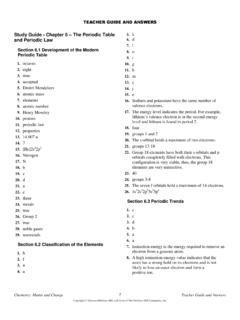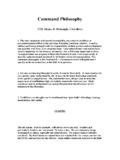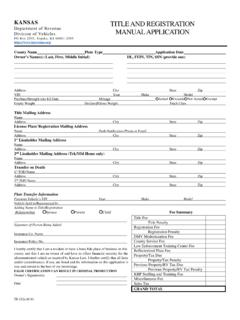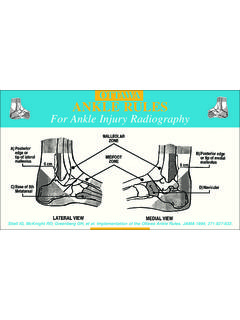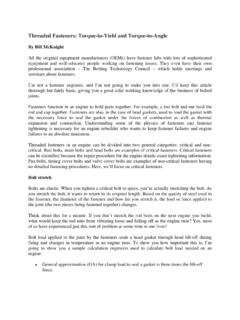Transcription of Chemistry: Matter and Change - Mr. McKnight Clawson High ...
1 Chapter 5: Electrons in Atoms CHEMISTRY Matter and Change Section Light and Quantized Energy Section Quantum Theory and the Atom Section Electron Configuration Exit Table Of Contents CHAPTER5 Click a hyperlink to view the corresponding slides. Compare the wave and particle natures of light. radiation: the rays and particles alpha particles, beta particles, and gamma rays that are emitted by radioactive material Define a quantum of energy, and explain how it is related to an energy Change of Matter . Contrast continuous electromagnetic spectra and atomic emission spectra.
2 Light and Quantized Energy electromagnetic radiation wavelength frequency amplitude electromagnetic spectrum Light, a form of electronic radiation, has characteristics of both a wave and a particle. quantum Planck's constant photoelectric effect photon atomic emission spectrum Light and Quantized Energy The Atom and Unanswered Questions Recall that in Rutherford's model, the atom s mass is concentrated in the nucleus and electrons move around it. The model doesn t explain how the electrons were arranged around the nucleus.
3 The model doesn t explain why negatively charged electrons aren t pulled into the positively charged nucleus. Light and Quantized Energy The Atom and Unanswered Questions (cont.) In the early 1900s, scientists observed certain elements emitted visible light when heated in a flame. Light and Quantized Energy Light and Quantized Energy Analysis of the emitted light revealed that an element s chemical behavior is related to the arrangement of the electrons in its atoms. The Wave Nature of Light Visible light is a type of electromagnetic radiation, a form of energy that exhibits wave-like behavior as it travels through space.
4 All waves can be described by several characteristics. Light and Quantized Energy The Wave Nature of Light (cont.) The wavelength ( ) is the shortest distance between equivalent points on a continuous wave. The frequency ( ) is the number of waves that pass a given point per second. The amplitude is the wave s height from the origin to a crest. Light and Quantized Energy The Wave Nature of Light (cont.) Light and Quantized Energy The speed of light ( 108 m/s) is the product of it s wavelength and frequency c =.
5 Light and Quantized Energy The Wave Nature of Light (cont.) Sunlight contains a continuous range of wavelengths and frequencies. A prism separates sunlight into a continuous spectrum of colors. The electromagnetic spectrum includes all forms of electromagnetic radiation. Light and Quantized Energy The Wave Nature of Light (cont.) Light and Quantized Energy The Wave Nature of Light (cont.) The Particle Nature of Light The wave model of light cannot explain all of light s characteristics. Ex. Why heated objects emit only certain frequencies of light at a given temperature.
6 In 1900, German physicist Max Planck (1858-1947) began searching for an explanation of this phenomenon as he studied the light emitted by heated objects. Light and Quantized Energy The Particle Nature of Light (Cont.) Planck s study led him to a startling conclusion: Matter can gain or lose energy only in small, specific amounts called quanta. A quantum is the minimum amount of energy that can be gained or lost by an atom. Planck s constant has a value of 10 34 J s. Light and Quantized Energy The photoelectric effect is when electrons are emitted from a metal s surface when light of a certain frequency shines on it.
7 Light and Quantized Energy The Particle Nature of Light (Cont.) Albert Einstein proposed in 1905 that light has a dual nature. A beam of light has wavelike and particlelike properties. A photon is a particle of electromagnetic radiation with no mass that carries a quantum of energy. Light and Quantized Energy The Particle Nature of Light (Cont.) Atomic Emission Spectra Light in a neon sign is produced when electricity is passed through a tube filled with neon gas and excites the neon atoms. The excited atoms return to their stable state by emitting light to release energy.
8 Light and Quantized Energy Atomic Emission Spectra (cont.) Light and Quantized Energy The atomic emission spectrum of an element is the set of frequencies of the electromagnetic waves emitted by the atoms of the element. Each element s atomic emission spectrum is unique. Light and Quantized Energy Atomic Emission Spectra (cont.) What is the smallest amount of energy that can be gained or lost by an atom? A. electromagnetic photon B. beta particle C. quanta D. wave-particle Section Check What is a particle of electromagnetic radiation with no mass called?
9 A. beta particle B. alpha particle C. quanta D. photon Section Check Compare the Bohr and quantum mechanical models of the atom. atom: the smallest particle of an element that retains all the properties of that element, is composed of electrons, protons, and neutrons. Explain the impact of de Broglie's wave article duality and the Heisenberg uncertainty principle on the current view of electrons in atoms. Identify the relationships among a hydrogen atom's energy levels, sublevels, and atomic orbitals. Quantum Theory and the Atom ground state quantum number de Broglie equation Heisenberg uncertainty principle Wavelike properties of electrons help relate atomic emission spectra, energy states of atoms, and atomic orbitals.
10 Quantum mechanical model of the atom atomic orbital principal quantum number principal energy level energy sublevel Quantum Theory and the Atom Bohr's Model of the Atom Einstein s theory of light s dual nature accounted for several unexplainable phenomena but not why atomic emission spectra of elements were discontinuous rather continuous. In 1913, Niels Bohr, a Danish physicist working in Rutherford s laboratory, proposed a quantum model for the hydrogen atom that seemed to answer this question. Quantum Theory and the Atom Bohr correctly predicted the frequency lines in hydrogen s atomic emission spectrum.

